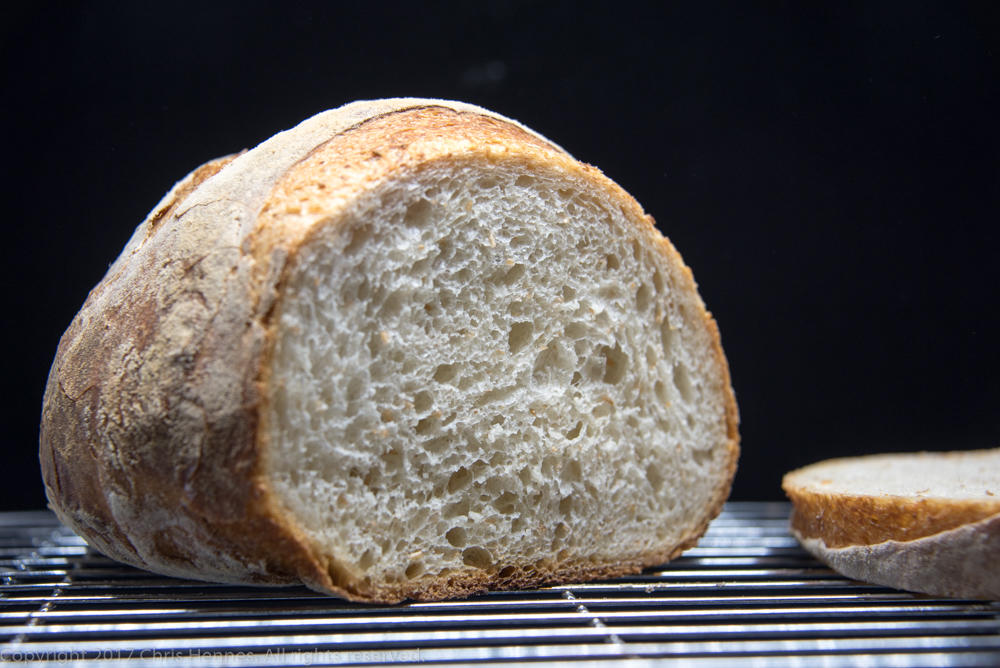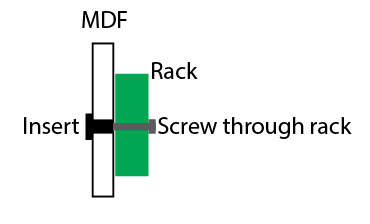-
Posts
10,190 -
Joined
-
Last visited
Content Type
Profiles
Forums
Store
Help Articles
Everything posted by Chris Hennes
-

Baking with Myhrvold's "Modernist Bread: The Art and Science"
Chris Hennes replied to a topic in Pastry & Baking
Right. I just pressed forward with mine, baked whatever came out of the couche after the final proof (I did mine at 39°F for 24 hours), and... voila! it worked. That said, I didn't have enough faith to actually bake after only five days, I let mine achieve full maturity before trying to make any bread with it. -

Baking with Myhrvold's "Modernist Bread: The Art and Science"
Chris Hennes replied to a topic in Pastry & Baking
A pretty normal home oven with a baking stone and a lid (a.k.a. a big hotel pan). -

Baking with Myhrvold's "Modernist Bread: The Art and Science"
Chris Hennes replied to a topic in Pastry & Baking
"Expert" is almost certainly too strong a word here! But in a word, no. I had a liquid layer very early on (days 2-4, maybe?) but now it's just a relatively uniform bubbly mass. And I took the hands-off approach when I started it, I literally just mixed it up and let it sit for 48 hours untouched. Now I'm feeding it at 40g/80g/80g. I find the book's discussion of this quite confusing, since they really give two completely different feeding schemes and I can't tell if that's intentional or not. There's the "discard 75% and replace it with equal parts flour and water" line (which works out to 67%/100%/100%), and there's the bakers percentage table which is 25%/100%/100%. The chapter says the starter isn't that sensitive to this, and that does seem to be the case so far, but I don't understand the huge variation here. Yes. Or at least, that's what I do. When it's feeding time on Fridays I don't discard the 75% portion, I just split it off and feed it as well (or as much of it as I need to create the levain for Saturday's baking). -

Baking with Myhrvold's "Modernist Bread: The Art and Science"
Chris Hennes replied to a topic in Pastry & Baking
Second-Chance Sourdough (p. 4•70) I've been maintaining a liquid levain for a few weeks now, but this weekend I was out of town for three days. Rather than try to find a levain-sitter I used the refrigerator technique, putting it into the fridge right after its last feeding and then taking it out and feeding it again as soon as I got home. So while not strictly-speaking "inactive", the levain I had for this recipe was definitely in the "hangry" category. The recipe is really just a basic direct-method lean bread with inactive levain added for flavor (scaled at 40%). The dough is relatively high hydration, so is quite sticky until the second four-edge fold, pretty much the same as the French Lean recipe. I mixed by hand, and bulk fermented at room temperature for four hours. Shaped small boules and proofed for almost two more hours and got this: Apparently the levain still had some energy, because the rise was very high, with a very open crumb (it's hard to tell scale from the photo, but for a "small" boule that thing is pretty big). While the crust and crumb texture was similar to a sourdough, I didn't get a whole lot of sourdough flavor out of this loaf. Presumably a lot of that depends on the exact state of your inactive levain, but apparently mine wasn't all that acidic. -
Yes, although it's now a proofer/retarder . The cool thing about it is that now that it's got all the bells and whistles I can set it to a very wide range of temperatures and humidities, so it's useful for more than just charcuterie.
-

Baking with Myhrvold's "Modernist Bread: The Art and Science"
Chris Hennes replied to a topic in Pastry & Baking
Done as in the gluten was fully developed. It passed the windowpane test. -

Baking with Myhrvold's "Modernist Bread: The Art and Science"
Chris Hennes replied to a topic in Pastry & Baking
I ignored the part about sealing the bag. I ran the vacuum cycle five times, then took the dough out of the bag. It was done. -
I don’t think so, I feel like I’d remember that. My recollection is that the CI bolognese “secret” was to use milk to make the meat mix more tender. Otherwise I think it was pretty similar to others out there, particularly Bugiali.
-
I’ve made both the spinach and the bechamel lasagnas from Cook’s Illustrated. I liked their treatment of the no-boil pasta, which I thought gave a final product that was much more like fresh pasta. But for a “war”? Go big or go home! Make your own pasta :). Roll it thin, and make all your layers of filling thin. Then you get a lot of layers, which makes for a gorgeous presentation because it will slice very cleanly. Bugiali alternates bechamel, bolognese, cheese layers. I think last time I made it I wound up with twelve layers, it was glorious.
-
I will second this - I’ve made it many times, it’s my gold standard lasagna. He’s got a variant in there where you alternate layers of plain and spinach pasta, which looks really great if you have time for it. It is a far cry from the traditional Italian-American dish. I don’t know if for your contest that’s a plus or a minus.
-

Modernist Bread: French Lean Bread (MB Contest Topic #1)
Chris Hennes replied to a topic in Pastry & Baking
As @Anna N says, the times you see are correct. The mixer is giving the gluten a head start that mixing by hand does not. I've made this bread both ways, but without a side-by-side comparison I couldn't express a preference for one over the other except to say that making bread completely by hand is very satisfying. I didn't even use a spoon. After scaling the ingredients I did the mixing literally by hand, on the counter. No centrifuge or anything! Then you just fold it every thirty minutes until it passes the window-pane test. Shape, proof, and bake. -
I'm assuming there are multiple routes because it's almost always true. This becomes more and more true as we better understand the exact physics behind the phenomena we are trying to replicate. Take kneading: you can make a bread by kneading the dough. If you do that, you shorten the proof time and get a loaf of bread faster. If you don't knead, it takes a couple more hours for the gluten to form. But you get the same final texture. So sure, you can't make just one change and expect to get the same result, but if you understand exactly what's going on, you can make combinations of changes that get the same end result.
-
The Wisconsin knock-offs don't taste the same. If you could arrive at something that actually tasted like Parmigiano Reggiano via some other method (Matter replicators, anyone? Sign me up! ) I'd happily eat it. To a good approximation I only care about the finished product. If you serve me a pizza that is functionally indistinguishable from a "True Verified Authentic Certified AVPN Neapolitan Pizza" then I don't care if it wasn't made the traditional way, and while of course it can't be labeled "AVPN," calling it "Neapolitan" as a descriptor seems completely reasonable to me. And I don't see how producing an excellent pizza can be disrespectful of the culture of Naples!
-
My mistake here, I was paraphrasing. Here's what the book actually says: That said, where you and I differ most fundamentally is that I don't care at all what the "official definition" says. This is due mostly to the fact that the definition focuses not just on the qualities of the finished product, but on how you must arrive there, whereas I only care about the finished product.
-

"Modernist Cuisine: The Art and Science of Bread"
Chris Hennes replied to a topic in Cookbooks & References
Now that the book has been released, we've split off the actual baking discussion here. -
I think you'll find page 5•102 a very interesting read -- it's called "The conflicting stories of the history of pizza." On the next page, where they lay out the various styles of pizza the book includes, for the attributes that make a pizza "traditional Neapolitan" they list: Crispy bottom Bubbly crust Leoparding Sparse toppings Which points here do you disagree with?
-

Magnetic Knife Strip, Be It Wooden, Stainless, Whatever
Chris Hennes replied to a topic in Kitchen Consumer
For the record it's not the weight of the knives I was worried about, it was the constant pulling them on and off, which is a direct tension force applied to those screws. Also, I tend to overengineer things . -

Magnetic Knife Strip, Be It Wooden, Stainless, Whatever
Chris Hennes replied to a topic in Kitchen Consumer
Sure -- the product I'm talking about is this sort of thing: E-Z Lok Threaded Insert, Zinc, Hex-Flanged, 3/8"-16 Internal Threads, 25mm Length (Pack of 25) They come in two styles, flanged and unflanged. The flanged ones look like this: If you install that so that that flange (the lip around the outside that prevents it from sinking down too deep) is actually on the back of your MDF, rather than the front, then you'll be pulling it tighter when you tighten down the screws for your knife strip. Here's a side view: -

Magnetic Knife Strip, Be It Wooden, Stainless, Whatever
Chris Hennes replied to a topic in Kitchen Consumer
With MDF I'd use a metal threaded insert to increase the thread grip area. If you can install the insert with the flange on the back side of the divider you'll have a very, very high strength connection. -

Magnetic Knife Strip, Be It Wooden, Stainless, Whatever
Chris Hennes replied to a topic in Kitchen Consumer
I've got a basic cheap one, mostly metal with a bit of plastic. It's just attached with screws through the front into heavy-duty drywall anchors. I didn't use the anchors that came with the kit, I bought a stronger variety because I figured I'd be giving mine more use than the cheap ones are typically designed for. It wasn't long enough to attach to the studs. I'm a big fan of this kind of knife storage. I've heard of people winding up with their knives magnetized, but I'm not sure I'd even notice such a thing, so I guess I don't care. -
Considering how much the restaurant changed from 2011 to 2017 it would be hard to imagine any duplication at all!
-
First, this isn't their "Neapolitan" recipe, it's their "Modernist Neapolitan" recipe. Second, what characteristic of the pizza do they change so much that it is no longer recognizable as "Neapolitan" pizza? According to the book the two ingredient essentially counteract each other in the final product. The lecithin is added as a dough relaxant to make shaping easier, and the polydextrose to counteract the lack of crispness that the lecithin causes. Here the Modernist twist isn't designed to change the end product, it's designed to make the dough easier to work with.
-

Modernist Bread: French Lean Bread (MB Contest Topic #1)
Chris Hennes replied to a topic in Pastry & Baking
Well, it’s going to be over-proofed right out of the fridge basically for sure (though I guess test it anyway, who knows). But the good news is that one of the most useful tests they did for the books was to see how many times you could overproof and then re-fold and proof again. The answer was something like ten times! So if it is overproofed in the morning I’d give it a four-edge fold, wait a half hour, then shape and proof again. -

Modernist Bread: French Lean Bread (MB Contest Topic #1)
Chris Hennes replied to a topic in Pastry & Baking
The book has a nice bit of information on low-temperature proofing, but unfortunately they report that this particular type of bread doesn't do well with more than 5-6 hours of cold-proofing time for the larger loaf sizes (and only 2-3 hours for baguettes and rolls!). How long did you have to hold it? -
In this case it's not even necessary to agree to disagree: the book presents both Modernist and more traditional recipes, which I think is only natural considering the team they assembled to produce it. Modernist Bread is a distillation and expansion of our past bread-baking experience, not a rejection of it.




